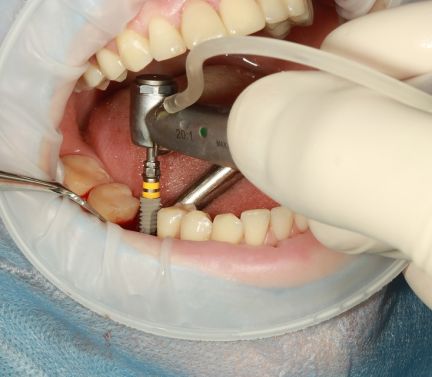Dental Implants – Procedure and Benefits

Dental implants are gaining popularity as an effective means to repair or replace missing teeth. This restorative procedure, though slightly expensive, produces great and long-lasting results. Here is more to know about these dental devices, how they function, how they are placed into your mouth, and what their benefits are.
How do dental implants work? What’s the procedure?
Implants function as substitutes to the roots of missing or affected teeth. These screw-like appliances made of titanium mimics the entire tooth structure and are placed into the bone surgically. This metal ‘root’ functions as the anchor on to which crowns, bridges, or dentures can be fixed. Single implants are used as a replacement to individual missing teeth. Full arch implants, which use multiple titanium screws, are used for patients seeking solutions for full mouth restoration or reconstruction. They are often used to support dentures and bridges and provide a ‘fixed’ solution to missing teeth. Implants are recognized as a state of the art technology with advantages over earlier treatments. They provide a permanent solution and are extremely useful to people with one or more missing teeth, broken teeth, or damaged teeth, which are beyond repair.
Benefits of having dental implants
There are many benefits of having dental implants Springfield. Here are some important ones.
Implants look and feel like natural teeth
Implants have the ability to restore full chewing power. When you get one fixed in your mouth, you can hardly tell the difference between an implant and a natural tooth. With such a prosthetic, you can bite, chew, brush, and floss as always without any worries.
They are long-lasting
Implants are designed to last a lifetime as opposed to bridges, which typically have a lifespan of about ten years. This long-lasting power can be attributed to the material it is made from – titanium – as well as the fact that it is integrated with the jawbone. The structure is non-toxic and biocompatible, meaning your body will not repel or reject it.
They save you from gum disease
The gap left behind by a missing or broken tooth actually acts as a trap for food particles. When lodged for a long time, this can cause bacteria to grow, resulting in cavities on adjacent teeth as well as in gum diseases that affect your oral health. Having an implant prevents this by replacing the affected tooth and allowing you to practice every day cleaning of teeth and gums as usual.
Dental implants prevent bone loss
Bone loss happens when there are no tooth roots that keep the jaw bone stimulated. The bone area loses its volume, and the deterioration continues over the years. Dentures sometimes accelerate this loss when they are loose and rub against the bony ridge, causing the bone to wear away. An implant, however, prevents this by mimicking natural teeth and restoring chewing abilities, which provides necessary stimulation for natural bone growth and its healthy retention.
They provide stability to adjacent teeth
The gap that results from a missing tooth often causes adjacent ones to shift crookedly towards the empty space. This affects your ability to chew and bite properly, as well as your appearance. Poor biting and chewing can also lead to issues with the temporomandibular joint, resulting in locking, clicking sounds, pains, and headaches. An implant prevents this by filling in the gap and helping adjacent tooth retain their position and alignment for normal functioning and appearance.
Implants prevent facial sagging
When bone loss occurs from missing teeth, it results in facial sagging. The lower third of the face begins to collapse, thereby causing the distance between the chin and the nose tip to gradually reduce. When this happens, it causes excess wrinkles around the mouth, thinning of the lips, as well as a pointed chin, all of which make a person appear a lot older than his or her true age. If you think you are a candidate for dental implants, visit your general dentist Springfield VA. He or she is the first resource who can perform this procedure or refer you to a periodontist, prosthodontist, or oral surgeon, if necessary.
